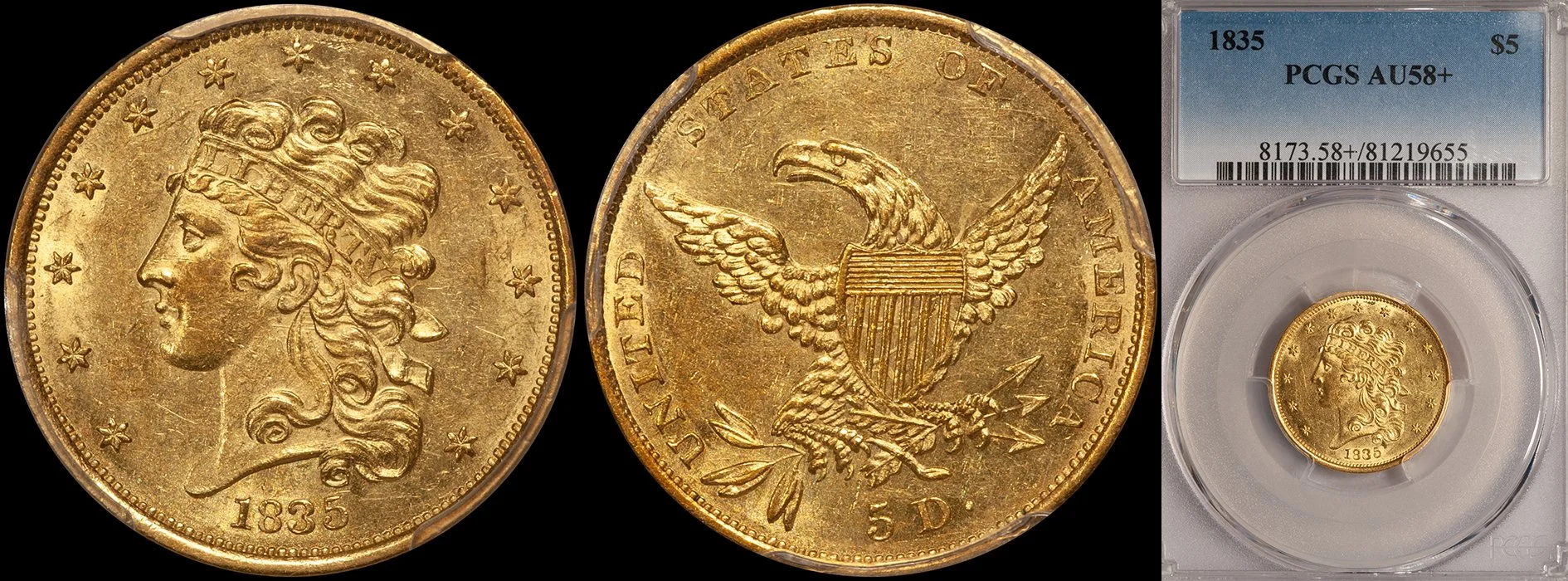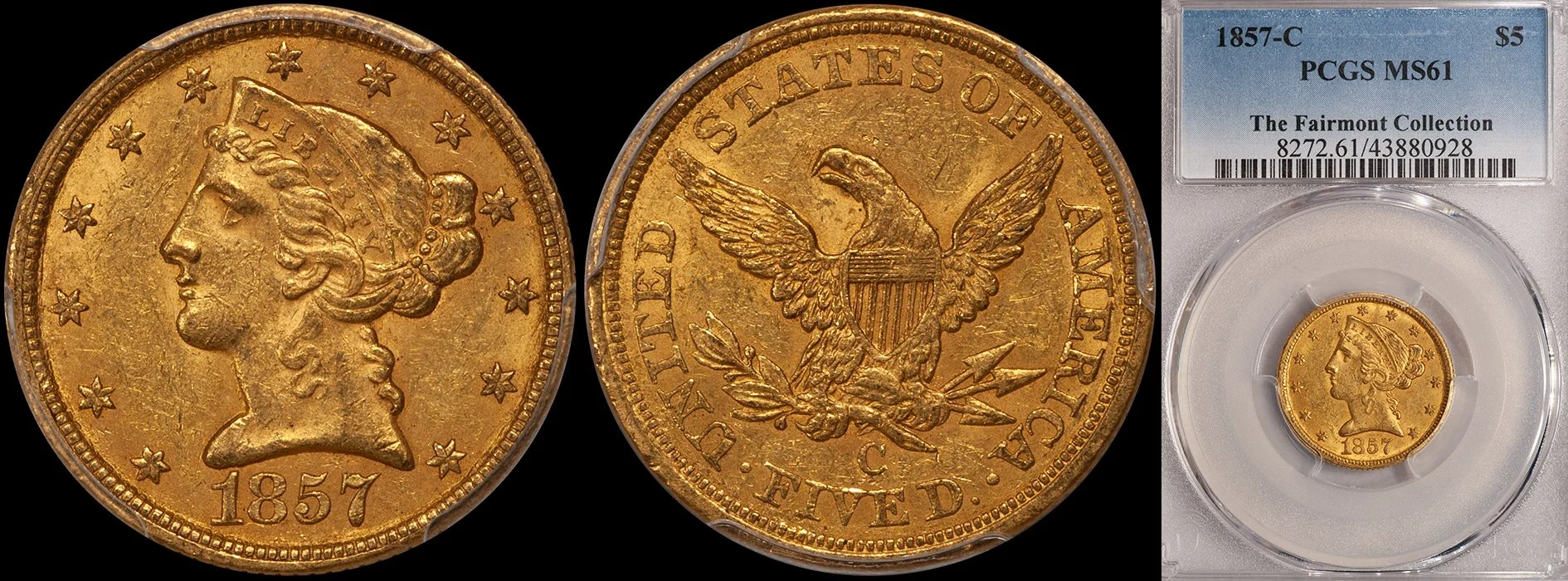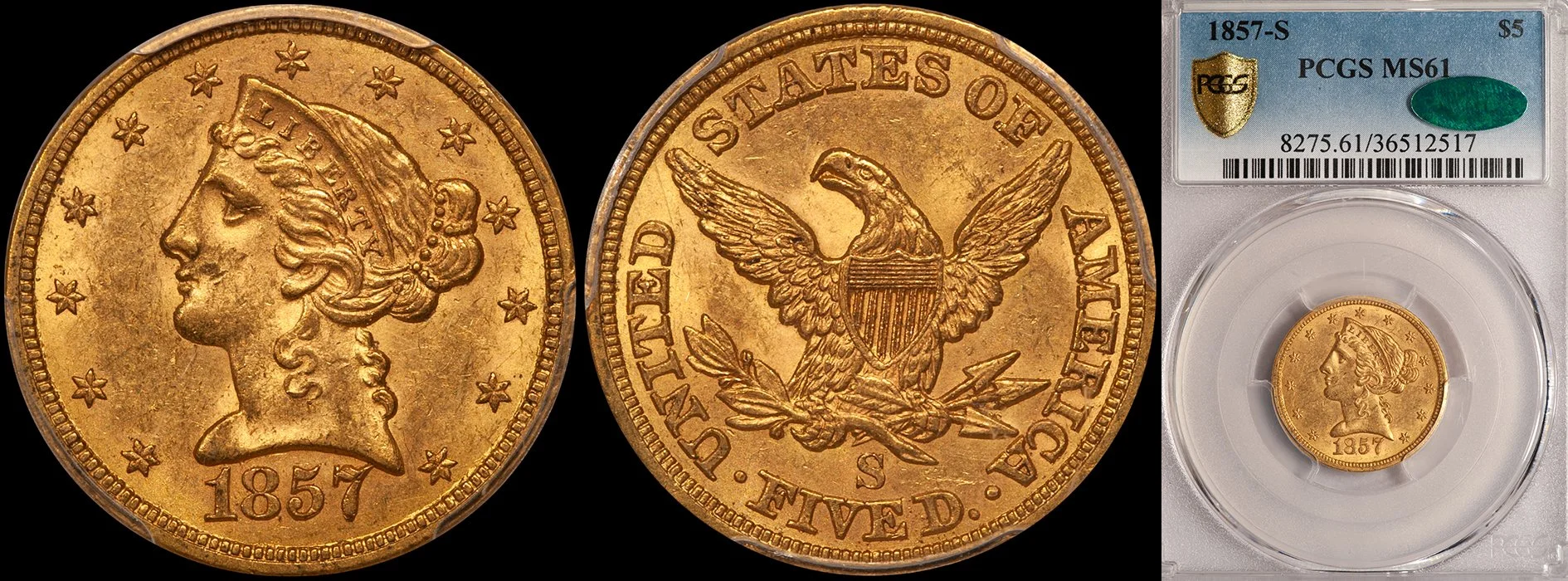What Was Lacking from Fairmont/"Hendricks": What We Have Learned from the Missing Pieces of the Puzzle
/Part One: Half Eagles
The April 2022 Stack’s Bowers sale of the Fairmont/”Hendricks” set of Liberty Head half eagles, eagles, and double eagles has been analyzed by a number of numismatic sources, myself included. All of the articles have focused on what was included in this sale. I thought it would be interesting to analyze what wasn’t present, as this information is extremely important as well.
Before we begin to look at specific coins, it is important to note that there are a number of common and very common dates which have either not been run through Stack’s Bowers primary auctions or which have been sold via methods other than auction. After all, why would Stack’s Bowers, as an example, run 150 very common date half eagles (say 1881-P in AU55) at auction when they can easily sell them with one phone call to a dealer who is a market maker in generics?
This article has an obvious inherent flaw: it can’t see into the future and assume that there aren’t certain coins which have been missing through April 2022 but which might appear in future Fairmont offerings. As an example, prior to the appearance of the marvelous PCGS/CAC AU58 1864-S half eagle in the April 2022 sale (Lot 5110), I would have bet a lot of money that there were zero examples of this rare date in the Fairmont Hoard. The same goes with the 1875 half eagle (Lot 5137), the 1863 eagle (Lot 5274), the 1870-CC double eagle (Lot 5413), and so on and so forth…
Here are a number of specific issues or types of half eagles (plus two broader categories) which have not appeared in any of the Fairmont sales (dating back to early 2018) or if they have appeared (infrequently) are worthy of a discussion. Most were also conspicuous by their absence in the Fairmont/”Hendricks” sale.
1. Early Gold
It has been my experience that very few pre-1834 US gold coins were shipped to Europe. There have been significant discoveries of early gold in Europe, but most of them are coins which were obtained by visitors to the US who bought them as souvenirs or curiosities and transported them back to the UK, France, and Switzerland or wherever else they were traveling from.
1800 $5.00
It is important to remember that old tenor US gold coins became worth more than face value in 1834 when the weight of the three types ($2.50, $5.00, and $10.00) were reduced and the fineness was decreased. This meant that huge numbers of pre-1834 gold coins were melted.
There have been a limited number of Classic Head half eagles in the various Fairmont sales but virtually every one of these has been well-circulated with most in the EF40 to AU50 range. I’m a little surprised—but barely so—that there haven’t been at least a few in the lower Mint State grades.
What we’ve learned: Pre-1834 US gold coins circulated in a different manner than their Liberty Head and 20th century counterparts. Most were melted by the time the original sources of the Fairmont Hoard began accumulating coins, and 95%+ of the coins which have been located overseas are individual coins obtained by travelers to the US ca. 1795-1834.
2. 1841 Half Eagle
Since the beginning of 2017, only three 1841 half eagles encapsulated by PCGS have sold at auction. One of these, a PCGS/CAC AU53 ex Stack’s Bowers 8/2020: 1342, was from the Fairmont Hoard. No other 1841 half eagles from this source have yet to appear in any Stack’s Bowers auctions.
1841 $5.00 PCGS AU53 CAC, courtesy Stack’s Bowers
I purchased some miscellaneous Liberty Head half eagles from Stack’s Bowers on a wholesale basis in 2018 which, if I recall correctly, contained one or two 1841 half eagles in Extremely Fine which weren’t designated as being from the Fairmont Hoard but which clearly were. From an overall perspective, it appears that this date is under-represented in the Fairmont holdings. What I find curious, is that the 1842 Small Letters and Large Letters half eagles (both of which are significantly scarcer than the 1841) appeared in the “Hendricks” set sold by Stack’s Bowers in their April 2022 sale, while the 1841 did not.
What we’ve learned: In the higher circulated grades EF45 to AU58, the 1841 is a really scarce coin. For some unknown reason, this date (along with the two varieties of 1842 half eagle) didn’t circulate in the same pattern as the other P mint half eagles from this era.
3. 1842-O Half Eagle
This and the next date (see below) will come as no surprise to anyone who is familiar with New Orleans half eagles. There are not more than 70-80 known in total and I am not aware of more than nine or ten AU 1842-O half eagles, along with three in Uncirculated (all sold by DWN to the New England Collection).
1842-O $5.00
The mintage of this issue is low (just 16,400) but there are other lower mintage dates from New Orleans produced during this era (1843-O Small Letters with 19,075 struck) which have been included in prior Fairmont offerings.
The “Hendricks” 1842-O half eagle was a no grade due to some deliberate deep scratches in the left obverse field. If there prove to be none in the upcoming Fairmont auctions, the 1842-O will remain comfortably ensconced as the second rarest half eagle from New Orleans.
What we’ve learned: As I’ve written in a previous article about the Fairmont coins, this massive hoard has proven to me that 99% of the Liberty Head half eagles that I have long believed to be rare are exactly that. Unless something extremely surprising occurs, the 1842-O half eagle will remain a real scarcity in EF45 and finer.
4. 1842-C Small Date Half Eagle
I’ve got a love/hate relationship with this issue. What I love about the 1842-C Small Date half eagle is that it is a truly rare issue with a very low mintage of 4,595. What I hate about it is that most of the slabbed coins—from both services—are absolutely vile with pieces which look like this or like this in AU58 holders.
1842-C Small Date $5.00, Lot 5022, courtesy Stack’s Bowers
There has been a single 1842-C Small Date half eagle sold in the various Fairmont auction offerings since 2018. Offered as “Hendricks:” 5022, it was an AU details coin (PCGS) that I thought had a good shot at straight grading. Given its sale price ($28,800), at least two bidders felt the same way, and I wouldn’t be surprised in the least if this coin turns up soon in an AU53 or even an AU55 holder.
What we’ve learned: Very few Charlotte half eagles can be termed as “rare” from an absolute sense, but the 1842-C Small Date certainly can. I would have expected a few lower grade pieces (VG to Fine) to have shown-up by now in the Fairmont holdings but we may well not see another.
5. 1847-O Half Eagle
As I’ve written before about this date, if you like the 1842-O half eagle, you’re going to love the 1847-O. While there are as many as 60-70 known, you can count the number of nice ones extant on one hand.
1847-O $5.00
I was selfishly hoping that there was a crisp, crusty 1847-O half eagle in the “Hendricks” set as I have been working on a personal set of New Orleans half eagles for the last few years and this date is a gaping hole in my all-PCGS/CAC collection. I honestly can’t remember the last really choice EF example that I’ve handled and now that my secret is out, I’m sure I’ll have to dramatically overpay to get a shot at one.
What we’ve learned: Not only is this a rarity in the New Orleans No Motto half eagle subset; it finally needs to be recognized as a Condition Rarity which stands along the far more expensive Civil War issues.
6. 1860-S Half Eagle
The 1860-S is a date which I feel doesn’t get the respect it deserves both an absolute rarity and a condition rarity. There are likely not more than 50-60 known with many of these in very low grades. In the various Stack’s Bowers sales which have offered Fairmont Fives, there have been three examples sold: a F15 in March 2021, a VF25 in November 2020, and a VF30 in August 2020.
1860-S $5.00
Just for grins, I went through my database of US gold coins and discovered that in the last 10 years, I have actually handled fewer examples of the 1860-S than I have of the very rare 1864-S (it should be pointed out that I’ve handled two 1860-S half eagles in AU55 or higher, and just one 1864-S in this grade level).
I think it was a clerical error that there was no 1860-S half eagle in the “Hendricks” set and I wouldn’t be shocked if there were a few lower grade examples remaining in the Fairmont Pipeline. But this overlooked date has gained some exposure as a result of its exclusion.
What we’ve learned: While overshadowed by the Civil War half eagles from both Philadelphia and San Francisco, the 1860-S is actually rarer than all of these in higher grades (AU55 and finer) except for the 1864, 1864-S, and the 1865. At its current PCGS Price Guide value of $15,000 in AU55 and $27,500 in AU58, it is a great value.
7. 1878-CC Half Eagle
Since half eagles from the Fairmont Hoard began surfacing in early 2018, there have been a surprising number of really nice Carson City coins. But most of these have been dated 1880 and later.
1878-CC $5.00 courtesy Stack's Bowers
In the “Hendricks” set sold in April 2022, every pre-1880 half eagle from Carson City graded at least EF45 except for two: the 1872-CC (Lot 5129) which was net graded “AU details—tooled” and the 1878-CC (Lot 5146) which was a PCGS/CAC VF35 (and which still sold for an absurd $38,400 or 10% more than this PCGS AU50 did in another session of the same sale.
What we’ve learned: While just a smidge less rare than the 1873-CC, the 1878-CC is a really tough coin in higher grades. I think it is the second rarest CC half eagle in AU and higher, and I have actually seen nearly as many nice AU 1870-CC half eagles as I have 1878-CCs (but not very many of either…) The crazy price realized by the “Hendricks: 5146” coin may have been a one-time anomaly, but the 1878-CC seems to have—at long last—become one of the Big Boys in the CC half eagle series.
8. Pre-1885 Proof Half Eagles
One of the more interesting things about the Fairmont Hoard has been the relatively large number of Impaired Proofs which have been present.
It has been common knowledge for many years that significant numbers of Proof gold coins entered circulation either during the year they were struck (or very soon afterwards) due to the fact that they were excess coins with no collector demand, or during the Depression when $5.00 was a substantial amount of money for many Americans and a common date Proof half eagle from, say, 1898 had very little numismatic value.
1885 $5.00 PCGS PR58 CAC, lot 5158 courtesy Stack’s Bowers
Lot 5158 in the “Hendricks” sale was a PCGS/CAC PR58 1885 half eagle which appears to be the earliest date Proof half eagle seen so far from the Fairmont Hoard.
What is the significance of 1885 as the cut-off date for Impaired Proofs in the Fairmont Hoard? My guess is that this is somewhat arbitrary and that there are older Proofs which suffered the same fate but are either not in this group, or that the older dates were recognized as being rare as Proofs and were worth enough of a premium that when they were offered to coin dealers in the early years of the Depression, they were not eventually spent.
What we’ve learned: I wouldn’t be surprised in the least if there are Impaired Proofs dating back at least a decade prior to 1885 in upcoming Fairmont offerings. But for now, the cut-off date remains at 1885.
9. 1892-O Half Eagle
Given that there have been multiple examples of the 1893-O and 1894-O half eagles in the Fairmont Hoard, I wondered if there would be examples of the scarce 1892-O. Based on what we have seen as recently as April 2022, this date is not present in the quantity which its more common counterparts are.
1892-O $5.00 PCGS MS60 CAC, lot 5168 courtesy Stack’s Bowers
“Hendricks:” 5168 was graded PCGS/CAC MS60 and it brought $8,400. There has been only one other 1892-O half eagle in the various Fairmont Hoard offerings since 2018; a PCGS AU58 which sold for $5,280 in the Stack’s Bowers 8/2020 auction.
It was interesting to note that the PCGS/CAC MS60 had the same appearance that 99% of the 1892-O half eagles which I have seen possess: exceedingly abraded with fairly dull luster. The only notable difference was that the “Hendricks” coin had nice color which is not typical for this issue.
What we’ve learned: The 1892-O shouldn’t be as scarce as it is, especially in MS62 and finer. I’ve long expected there to be a secret hoard of these but there clearly are not.
Part Two of this article will feature eagles and double eagles which have been absent or under-represented in the Fairmont Hoard as of April 2022.
For more information on collecting Liberty Head half eagles, please feel free to contact me by email at dwn@ont.com or by phone/text at (214) 675-9897.





















